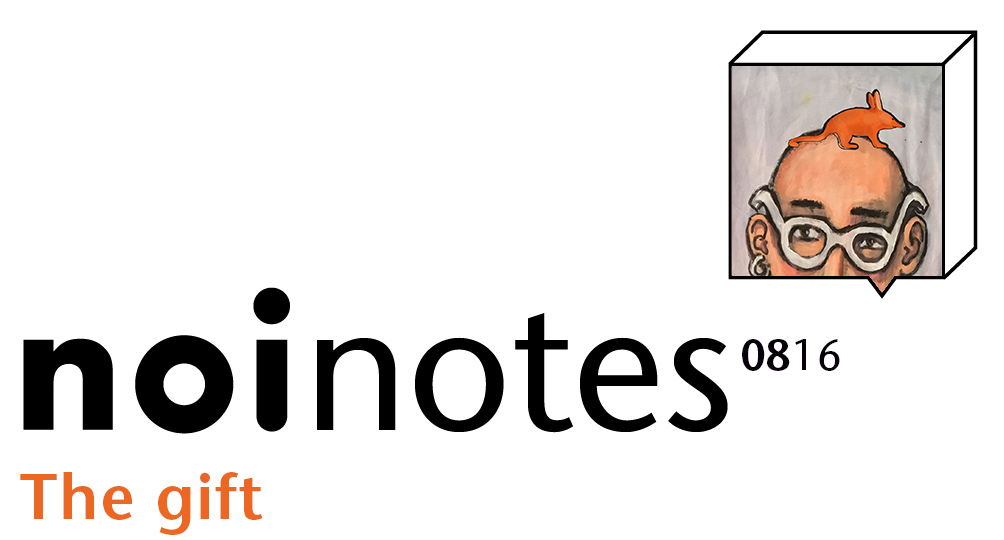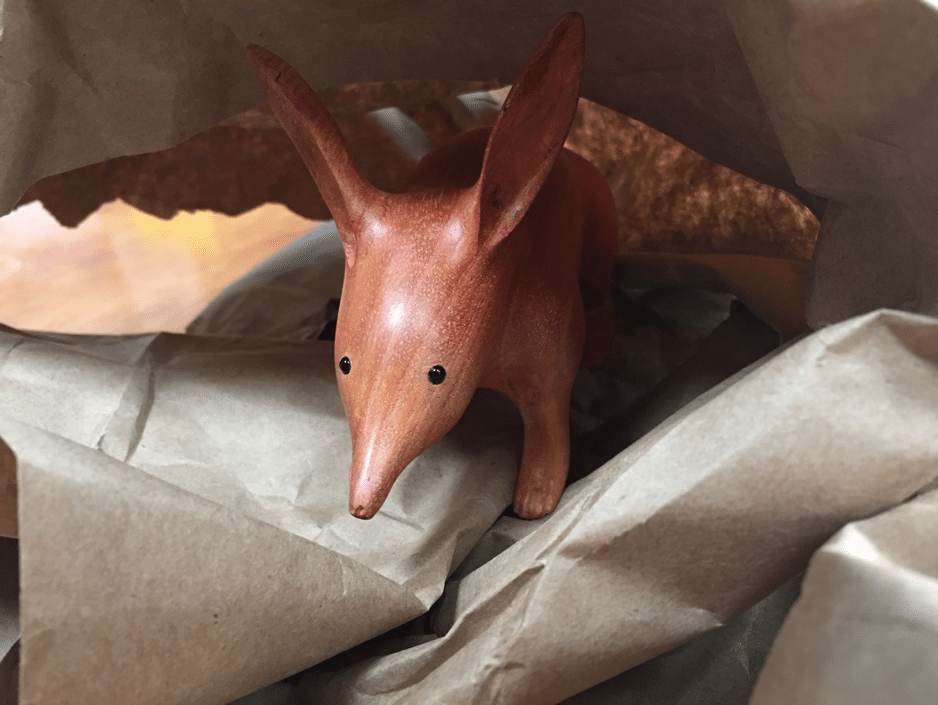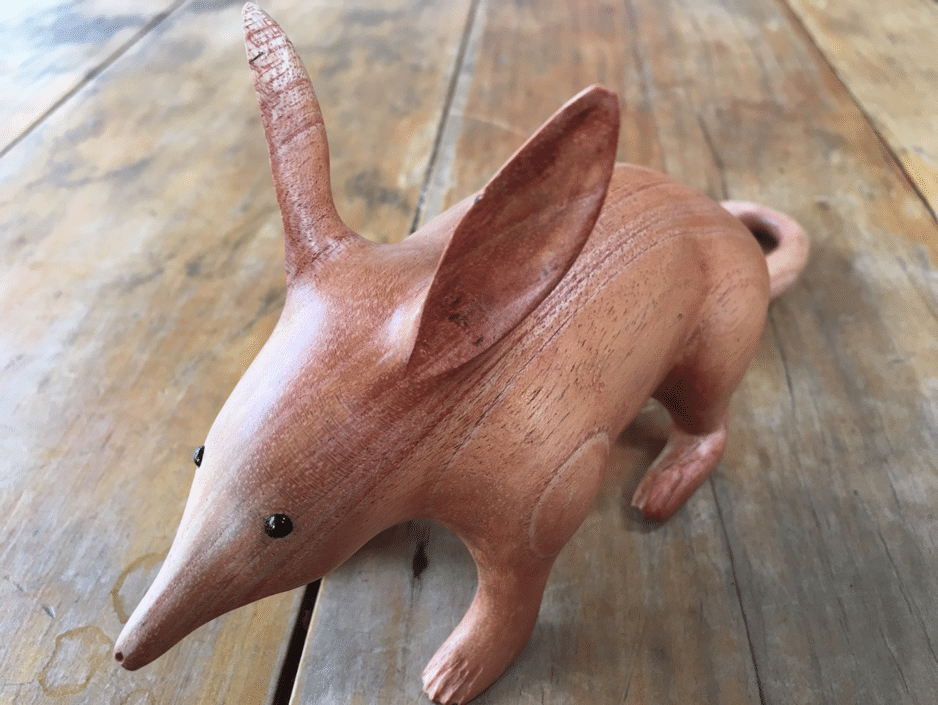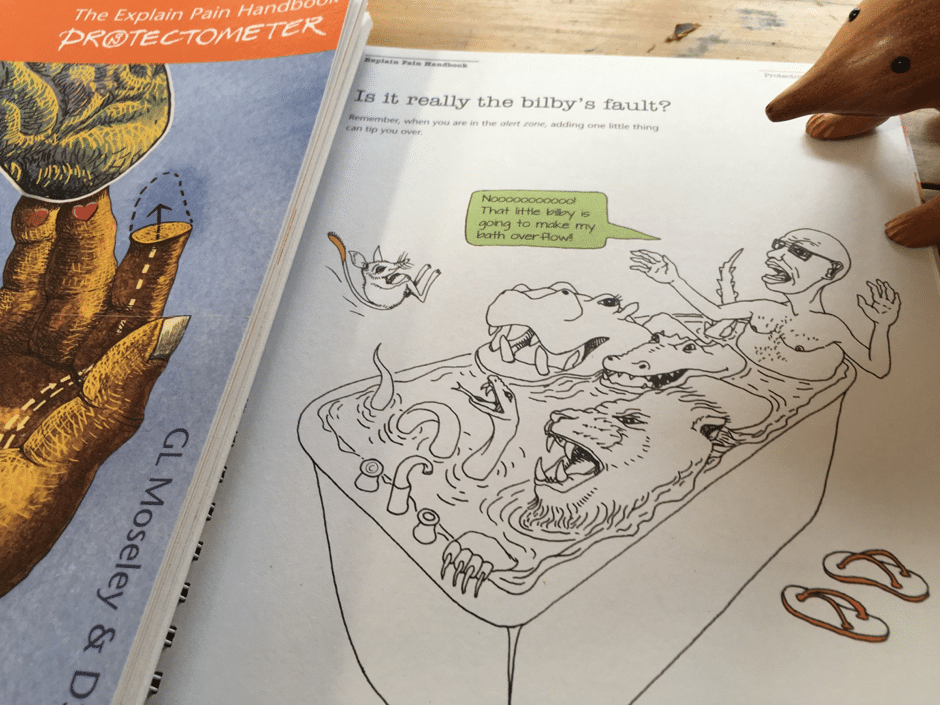
Grateful patients often bring gifts to clinicians. I have had some rippers over the years ranging from half a sheep, gallons of wine, to shirts of every possible colour. A friend of mine was offered a car once, but that’s another story. Last week a very special gift, beautifully wrapped and with FRAGILE stickers all over, arrived in the mail. I had not met the gifter but he had read and used Explain Pain and The Explain Pain Handbook: Protectometer and I knew he had chronic pain and post-traumatic stress. Out of the wrapping emerged a wooden bilby, hand carved by the gifter.
One hundred hours of labour
For the non-Aussie readers, a bilby is a small desert dwelling burrowing marsupial, now sadly endangered. Most Aussies know about the bilby because it’s a mascot for Australian endangered animals, the cute factor due to its big ears, and recent attempts to replace the chocolate Easter bunny with the Easter bilby.
I caressed my bilby. It was smooth and invited handling. Beautifully carved from precious Queensland Red Cedar that smelt of the forest. I studied the intricacies of the craft – each ear was different, there were the honest marks of hand tools left by the creator, and a unique signature marked his belly. I estimated it must have taken the carver around a hundred hours.
The most powerful drug used
I felt quite moved by the gift and I tried to work out why. After all, I had been given plenty of gifts before. First, and most powerfully, there was a letter that accompanied the bilby – three pages of carefully hand written cursive. With no ability to cut and paste or delete and re-type, a hand written letter suggests a great deal of planning and thought, and multiple drafts – even before the content, a handwritten letter is a gift in itself.
The content of the letter was very emotional – a personal journey through hardship, conflict, and finally, a path to recovery;
“I now know that pain comes from the brain 100% of the time. I resisted this for a long time. I also now know the PTSD comes from the brain as well’.
Wow – I know this is a key concept in Explain Pain, but I also know that it can be really difficult to truly accept. I imagined him considering this message during those many hours of hand carving and shaping. It seems my bilby-maker really understood ‘The brain is boss’. I was reminded of Rudyard Kipling’s famous quote,
“Words are of course, the most powerful drug used by mankind.”
When you can use words to explain pain to yourself and others, then you’ve got it! What a powerful learning tool!
It’s so easy to blame the minor things
Secondly, the ‘Bilby in the bath’ is a key part of The Explain Pain Handbook: Protectometer where the little bilby is blamed for the bathwater overflowing, forgetting all the large and sometimes nasty DIMs (Dangers in Me) already lurking in the bath. It’s so easy to blame the minor things for pain or stress – the cold, what someone says, a posture, an x-ray, a label, a diagnosis or a movement, rather than looking more deeply.
And even more, I hoped and thought the bilby must be a symbol of progress and carving it a creative help. I have always asked patients, ‘What has your problem done to your creative life?’ in the belief that restoration or new creativity is highly therapeutic, wakening the brain’s own problem solving abilities.
The bilby now resides in pride of place in our office. I can’t think of Mr. Bilby as mine though – it’s for co- writer Lorimer Moseley too, everyone in the NOI office and every scientist, educationalist, writer and clinician who has played a part in the Explain Pain movement.
Drop in and check out the bilby if you are in Adelaide, and we would love to hear your stories about the gifts that have moved you in the comments below.
– David Butler




Beautiful and enspiring I’ve forwarded this to all my Protectometer patients…….
I’ll link this to my new Sunday series and mention the bilby (none in Ohio) in my ongoing quest to get the “critical state” at the reason pain often persists. Thank you for mentioning creativity too.
My best,
Barrett
Dear David, This piece really moved me. I have shared it with my clinical staff who spend each and every day helping people on their journey to understand their pain with varying degrees of success. I wished them many Bilbys. They deserve them! As do you, Lorimer and the Noigroup team who have helped provide us with the understanding and tools to be able to improve people’s lives. Thank you!!!
These are the stories that keep inspiring us. When people come ‘running’ down the hallway to greet and hug me and thank me for all I have done for them, I tell them that the real thanks goes to the people such as yourself who provide us clinicians with the research and information to do our job so well. Many many thanks.
I should also mention that many of the things contributing to any complaint of pain are hidden; invisible, like the animals “beneath the surface of the water in the tub.” This is why reasoning, premise, science and plausibility are so important. It is also why metaphor, story and uncertainty need to be understood.
Barrett
Many thanks David, Dianna, Barrett and Kristene.
A pleasure to share the piece with you.
david
What a beautiful and meaningful gift! Also well deserved. Thank you for sharing.
Heather Selfe OT, CHT
Thanks Heather,
I feel quite humbled by the number of emails and messages that I have had about this post. I know that the carver has also enjoyed it and found it inspirational.
David
Hi. I read your email about the upcoming new book Explain Pain Supercharged and the integration of the work on metaphor by G. Lakoff and M. Johnson. I know the work of these authors and I teach them at university. In this line, can be powerful to read the work of Cognitive Scientist “The Interface Theory of Perception”. Where the semiotic notion of “icon” is used as the sign to refer to reality (brain, tables, etc.). Better read it yourself, link: http://www.cogsci.uci.edu/~ddhoff/interface.pdf I don’t think that this approach is true or false, I think is a hypothesis. As with metaphor and the way we experience pain and danger, maybe the “brain” icon as the source of pain reaction to a danger it is also a way to refer to a reality that is in other place, but that we can access to through the icons and indexes we call our experience. Maybe we have to put together the biological icon and cultural icon into play in an ecological approach to pain. I don’t know that much. Hope the book comes as an ebook as well. Best luck, Sergio